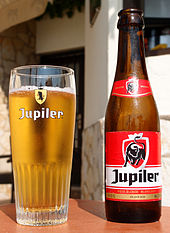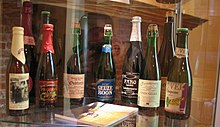Belgian beer

Belgian beer is one of the most diverse in the world. The origins of Belgian beer brewing go back to before the Middle Ages .
The Belgian “ Vandervelde Law ” of 1919, which banned the sale of spirits in bars and thus created a demand for beer with a higher alcohol content , had a decisive influence on the further development of the variety of varieties . The Vandervelde Act was not repealed until 1983.
The special importance of Belgian beer is also highlighted by beer experts like Michael Jackson . Although beer production in Belgium is now determined by ABInBev , the largest brewery group in the world, and Heineken , there are around 280 other breweries in the country that produce around 500 stand-alone beers. Along with special types of beer and craft brewing, there are more than 1000 varieties of Belgian beer.
In November 2016, Belgian beer was added to the list of intangible cultural heritage as a UNESCO World Heritage Site .
Distribution and packaging
Draft and bottle beers
The majority of Belgian beers are only sold in bottles because, unlike a Pilsner beer, they can still ripen in the bottle and can still gain flavor nuances during a storage period of two to three years. However, a storage temperature of four to ten degrees Celsius must be ensured.
The bottles are tinted brown or dark green in order to avoid negative effects of light ( light taste ) on the drink and closed with a cork, a metal crown cap or sometimes both. Yeast is added to some beers in the bottle for a second final fermentation process, for example Trappist beers . These are labeled with "bottle fermented". The main brands of beer are available practically everywhere, with special beverage centers across the country offering a wider range of special types.
There are different bottle sizes: 250 ml, 330 ml, 375 ml, 750 ml and multiples of 750. The 375 ml size is common for "lambics". Other beers are generally bottled in 250 or 330 format (depending on the brand). The larger bottles (750 ml) are sold in almost every grocery store, but the selection is often not very large. Larger bottles are referred to using the terminology used for champagne , but they are quite rare.
Bar and glasses
In principle, there is an individual glass for every beer. In addition to the basic shape of the glass (goblet with a wide opening, curved tulip glass, narrow Pilsener glass, etc.), each glass is printed with a company logo or name. The different basic shapes should optimally convey the taste and aroma of the respective beer.
Special feature: If you order a “demi” (“half”) in a Belgian café, you get a 500 ml glass, freshly tapped or from 2 bottles of 250 ml, whereas in France demi means a 250 ml glass.
Beer culture
The variety of Belgian beers goes hand in hand with a lively beer culture in thousands of bars called cafes, which offer a wide range of beers. There, each beer is served at its “ideal” temperature, which is normally 8–12 ° C within the cellar temperature range, and in a suitable glass.
Famous beer cafés in Belgium are, for example: “Beer circus”, “L'atelier”, “Moeder Lambic”, “ Délirium Café ” and “À la Mort Subite” in Brussels ; “De Kulminator” and “Kats” in Antwerp , “De Garre”, “Duvelorium” and “'t Brugs Beertje” in Bruges , “Het Hemelrijk” in Hasselt and “Het waterhuis aan de bierkant”, “Hopduvel” and “Trappistenhuis” “In Ghent .
Types of beer
Pilsner beer
Although Belgium is best known internationally for its unique top-fermented beers, it is the well-known bottom-fermented pale Pilsener that tops the consumption lists for both domestic consumption and Belgian beer exports. Probably the best-known brand internationally is Stella Artois (from InBev), while in Belgium Jupiler (also InBev) are the most popular along with Maes Pils and Haacht . There are also niche products such as Strubbe Super Pils (5% alcohol by volume), La Quenast (5%) and Pick-up Pils (4.8%).
Top-fermented beers
Strong beer "Blondes"
Light beer with a high alcohol content typically> 8%. Duvel , Delirium tremens , Ciney Blonde and Brigand are role models for this variety.
Amber, Belgian ale
Amber beers are a modification of the British top-fermented pale ale and were developed in the first half of the twentieth century as an adaptation to Belgian tastes. The result was an amber-colored beer with a slightly caramel-like taste. The market leader is Palm . A beer well known in Antwerp is produced by De Koninck and served in typical spherical glasses (called 'bollekes'). Other beers in this category are Dikke Mathile, Twels Pilsner Speciaal and Vieux Temps.
Dark beers
Kwak , Ciney Brune , Hoegaarden Forbidden Fruit , Chimay Bleu , Rochefort 8
India Pale Ale (IPA) type
Few Belgian beers are heavily brewed and hopped like English bitter or India Pale Ale . XX Bitters from De Ranke's Brewery and Hommelbier from Popering Brewery belong to this category. Sometimes the Trappist Orval beer is also assigned to this category.
Bière de Champagne / Bière Brut
So-called champagne beer is a relatively new type of beer. The beers mature in barrels for a long time. Then they are bottled and stored using the Champenoise method . Examples are Malheur Bière Brut and DeuS . This beer is increasingly being produced in other countries as well, and as a premium beer it is particularly popular in upscale restaurants.
Oud Bruin
A typical Flemish copper-colored to dark beer. Like lambic, it is mixed from different vintages. Good examples of this variety are Goudenband and Monk's Flemish Sour Red Ale . Oud Bruin is also a beer name in the Netherlands, but there are sweet beers with little alcohol. This should not be confused with the Flemish Oud Bruin .
Belgian red beer
Made famous by the Rodenbach brewery, which developed this type more than a century ago. The distinguishing features of this beer are a more intensely dried malt, fermentation with a mixture of 'ordinary' top-fermenting yeast and a lactic acid bacteria culture (the same type from which yoghurt is also made) and aging in oak casks. The result is a beer with approx. 5% alcohol, a deep reddish-brown color and a sour, fruity and intense taste.
Dubbel / double
Second fermentation beer with fine spices ( Enghien , Grimbergen Double ).
Triple / triple
Light or dark, heavily brewed using alcohol-tolerant yeasts, high alcohol content and intense taste ( Sint-Iedesbald , Brugse Tripel ).
Quadruple
Dark beers with a very high alcohol content, typically 9–13%. Typical representatives of this category are Bush ambrée , Rochefort 10 , Westvleteren 12 .
Witbier / Blanche
A special kind of unfiltered wheat beer that often contains spices like coriander and orange peel. Some classic examples are Binchoise Blanche , Hoegaarden , Brugse Witte and Steendonk .
Seasonal beer
A light, light-colored beer that has only been stored for a short time. It has a subtle caramel taste and max. 6.5% alcohol by volume. It is made in Wallonia in the Tournai area.
Spontaneous beers
Lambic
(See main article Lambic )
Unique in Belgium and differentiated by their sour taste, lambics are neither clearly top-fermented nor bottom-fermented, but are created through spontaneous fermentation using wild yeasts of the Brussels endemic strains Brettanomyces bruxellensis or Brettanomyces lambicus. There are different types of lambics. In its most natural form, lambic is a beer that has been fermented in wooden barrels for around three years and is rarely bottled and is only available in the production area (the Senne valley ) and in some cafés in and around Brussels.
Geuze / Gueuze
(See main article Gueuze )
Gueuze, also known as Brussels Champagne because of its bottle fermentation , is a sparkling beer that is produced by blending different lambics with subsequent second bottle fermentation.
Fruit lambic
(See main article Kriek )
Fruity beers are made by adding fruit or fruit concentrate to Lambic. The best known type is kirk with a cherry flavor. Other fruits used are, for example, raspberry (Framboise or Frambozen), peach (Pêche), black currant (Cassis) or strawberry.
Faro
(See main article Faro )
Faro is an old type of beer that is very popular in Brussels . Faro is reddish and is blended from several lambics. When bottling, Faro is not only added to spices such as pepper, orange peel and coriander, but also rock sugar for bottle fermentation. In the 1920s, Faro had almost been ousted from the market by Gueuze and Pils.
However, Faro is now being produced again by many breweries.
Further classifications
Abbey beer
(See abbey beer )
These are top-fermented beers that are either still produced in abbey breweries according to centuries-old recipes, or are produced under license by professional breweries. In the latter case, the abbey has no influence on the manufacturing process or on the marketing strategy. Probably the best-known international brand of Abbey beer is Leffe by Anheuser-Busch InBev. Others are Grimbergen , Tripel Karmeliet , Maredsous , Watou , Saint-Feuillien , Floreffe , and Val-Dieu .
Trappist beers
Top-fermented beer brewed in a Trappist monastery. To be qualified in this category, the entire production process must take place within the monastery or be supervised by Trappist monks. Only eight monasteries, all of which are in Belgium, the Netherlands or Austria, currently meet this qualification. Current Trappists are Achel , Chimay , La Trappe (Netherlands), Orval , Rochefort , Engelszell Abbey (Austria), Westmalle and Westvleteren .
See also
literature
- Ann-Marie Bernardt: On the trail of Belgian beer. GEV Grenz-Echo Verlag, Eupen 2005, ISBN 90-5433-201-8 .
Web links
Individual evidence
- ↑ "Unesco: Belgian beer becomes a world cultural heritage". Neue Zürcher Zeitung, November 30, 2016, accessed on December 1, 2016 .
- ↑ http://beeradvocate.com/beer/style










